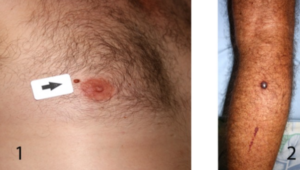Joe Biden, with the best medical access in the world, still ended up getting his prostate cancer diagnosis in late stage (4) after it’d already spread to his bones.
If a man with access to the best medical care could get a stage IV diagnosis of prostate cancer – which means a poor prognosis – is there anything the average man can do to prevent a late diagnosis?
Prostate cancer is highly curable when caught early: still localized to the prostate gland.
In fact, even a regional spread, meaning, the malignancy has metastasized beyond the prostate but is still nearby, has a very good prognosis.
But once this cancer, which can occur in men under 50, moves to a distant site (bones are the first place it wants to go), the outlook is grim – no matter how superb one’s healthcare resources are.
Preventing a Diagnosis of Advanced Prostate Cancer
“There are some important things a man can do to avoid a late prostate cancer diagnosis,” begins Jonathan Stegall, MD, an integrative oncologist and medical director for The Center for Advanced Medicine adult cancer treatment center.
“The most important factor is getting regular checkups with your doctor, which should include a PSA blood test and perhaps a digital rectal exam as well.”
Many men won’t even adhere to this basic protocol, even those of senior age (the most at risk) and with excellent healthcare benefits.
But if you have anxiety about prostate cancer, you actually have more control than you think when it comes to early detection.
#1 The PSA Blood Test

Shutterstock/Sherry Yates Young
A man may have read that the PSA test result can be inconsistent or high in the absence of prostate cancer, and thus, not want to bother with this simple blood test.
Furthermore, since 2020 there’s been the commercially available IsoPSA test.
A regular PSA test measures only the total amount of PSA protein in one’s blood.
But the IsoPSA can actually detect specific types of PSA proteins that are made by malignant cells. It’s more accurate than the standard PSA test.
Now, the big picture is that both the standard prostate-specific antigen test and the IsoPSA have a level of efficacy that makes these blood tests a mainstay for helping detect prostate cancer in a more curable stage.
#2 The Digital Rectal Exam

Some men are very uncomfortable with the idea of a digital rectal exam – even if they’re of senior age or have other risk factors.
“It is worth noting that the digital rectal exam is somewhat controversial since the exam has significant limitations in its accuracy,” continues Dr. Stegall.
“It’s for that reason I recommend the PSA blood test as the main method of prostate cancer screening.”
#3 The Galleri Test
Another blood test is also available: the Galleri test, launched in 2021.
Ask your doctor about this test, which is designed to screen for more than 50 types of cancer including that of the prostate.
“For men who are especially wanting to be proactive, I recommend routine Galleri testing to screen for cancer in the body,” says Dr. Stegall.
#4 Imaging Exams
“There are also imaging studies which can be performed for men who want to be proactive about their health,” says Dr. Stegall.
“Most notably, full body, non-contrast MRI screenings are designed to look for abnormalities, including abnormalities within the prostate.
“These tests are controversial, as they are not typically covered by insurance and can have findings which lead to potentially unnecessary testing.”
For example, the imaging might pick up something in the liver that needs more clarification.
The patient hears, “You have spots on your liver; you should get an MRI with contrast for a more accurate look.”
The patient is now worried he might have liver cancer.
The “spots” are actually far more likely to be harmless specks of blood vessel concentrations called hemangiomas (or angiomas).
Nevertheless, patients are encouraged to follow up on incidental findings with more sensitive imaging.
“However, these screening MRIs have also been shown to find cancer and other issues well before symptoms developed,” says Dr. Stegall.
Full body non-contrast MRI can be valuable especially in high-risk men (e.g., with family history, elderly age, African descent).
Studies show that MRI improves detection accuracy.
According to Ahmed et al. (2017), multi-parametric MRI has a higher sensitivity (93%) than does standard biopsy (48%) for clinically significant prostate cancer.
Although full-body MRIs aren’t standard for prostate screening, they can reveal incidental findings, including early-stage tumors, without radiation exposure.
As part of a preventive strategy, such screenings may help identify cancers before symptoms appear (Ghai & Haider, 2015; de Rooij et al., 2014).
#5 Don’t Ignore Symptoms!
Many men ignore urological symptoms such as frequent urges to urinate, burning during urination, trouble starting a stream or a weak flow.
They often assume it’s stress related, caused by aging or maybe just an enlarged prostate.
Or, they may make the assumption that they’re too healthy to have prostate cancer, or, “This can’t be prostate cancer because I’m only 42, I don’t drink and I hardly eat processed meats.”
However, these symptoms, along with a feeling of incomplete bladder emptying, blood in the urine or semen, erectile dysfunction and painful ejaculation can be early signs of prostate cancer.
Men frequently delay seeking medical attention due to embarrassment or misinterpreting symptoms (Merriel et al., 2018).
According to the American Cancer Society, prostate cancer is often asymptomatic in early stages, but when symptoms do appear, they may already indicate advanced disease.
“Of course, healthy lifestyle factors such as regular exercise, consuming a nutritious diet, managing stress and controlling weight are particularly important in preventing prostate cancer at any age,” says Dr. Stegall.


 Jonathan Stegall, MD,
Jonathan Stegall, MD,






































